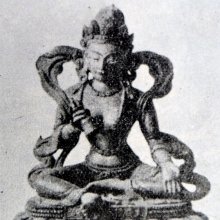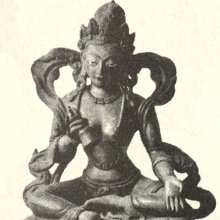Pratibhanapratisamvid, Pratibhānapratisaṃvit, Pratibhānapratisaṃvid, Pratibhana-pratisamvid, Pratibhanapratisamvit, Pratibhana-pratisamvit: 3 definitions
Introduction:
Pratibhanapratisamvid means something in Buddhism, Pali. If you want to know the exact meaning, history, etymology or English translation of this term then check out the descriptions on this page. Add your comment or reference to a book if you want to contribute to this summary article.
Images (photo gallery)
In Buddhism
Mahayana (major branch of Buddhism)
Source: Wisdom Library: Maha Prajnaparamita SastraPratibhānapratisaṃvid (प्रतिभानप्रतिसंविद्) refers to the “knowledge of elocution or, more simply, eloquence” and represents one of the four “unhindered knowledges” (pratisaṃvid), according to the 2nd century Mahāprajñāpāramitāśāstra chapter XL. Accordingly, pratibhāna-pratisaṃvid refers to “knowledge of elocution or, more simply, eloquence. This is the ability to speak in a precise and easy way resulting from mastery in regard to the Path (mārgavaśita) and unfailing attentiveness”.

Mahayana (महायान, mahāyāna) is a major branch of Buddhism focusing on the path of a Bodhisattva (spiritual aspirants/ enlightened beings). Extant literature is vast and primarely composed in the Sanskrit language. There are many sūtras of which some of the earliest are the various Prajñāpāramitā sūtras.
Tibetan Buddhism (Vajrayana or tantric Buddhism)
Source: archive.org: The Indian Buddhist IconographyPratibhānapratisaṃvit (प्रतिभानप्रतिसंवित्) or simply Pratibhāna refers to one of four Pratisaṃvit Goddesses, as commonly depicted in Buddhist Iconography, and mentioned in the 11th-century Niṣpannayogāvalī of Mahāpaṇḍita Abhayākara.—Her Colour is green; her Symbol is the bell; she has two arms.
Pratibhānapratisaṃvit is described in the Niṣpannayogāvalī (dharmadhātuvāgīśvara-maṇḍala) as follows:—
“On the North there is Pratibhānapratisaṃvit of the colour of anemerald (green), holding in her two hands a bell marked with a vajra with three thongs”.
[A statuette of this extremely obscure deity is found in the Chinese collection at Peiping.]

Tibetan Buddhism includes schools such as Nyingma, Kadampa, Kagyu and Gelug. Their primary canon of literature is divided in two broad categories: The Kangyur, which consists of Buddha’s words, and the Tengyur, which includes commentaries from various sources. Esotericism and tantra techniques (vajrayāna) are collected indepently.
General definition (in Buddhism)
Source: Wisdom Library: Dharma-samgrahaPratibhānapratisaṃvid (प्रतिभानप्रतिसंविद्) or simply Pratibhāna refers to the “analytical knowledge of inspired speech” and represents one of the “four analytical knowledges” (pratisaṃvid) as defined in the Dharma-saṃgraha (section 51). The Dharma-samgraha (Dharmasangraha) is an extensive glossary of Buddhist technical terms in Sanskrit (e.g., pratibhāna-pratisaṃvid). The work is attributed to Nagarjuna who lived around the 2nd century A.D.
See also (Relevant definitions)
Partial matches: Pratisamvit, Pratibhana, Pratisamvid.
Full-text: Pratibhana, Pratisamvid.
Relevant text
Search found 4 books and stories containing Pratibhanapratisamvid, Pratibhānapratisaṃvit, Pratibhānapratisaṃvid, Pratibhana-pratisamvid, Pratibhanapratisamvit, Pratibhana-pratisamvit, Pratibhāna-pratisaṃvid, Pratibhāna-pratisaṃvit; (plurals include: Pratibhanapratisamvids, Pratibhānapratisaṃvits, Pratibhānapratisaṃvids, pratisamvids, Pratibhanapratisamvits, pratisamvits, pratisaṃvids, pratisaṃvits). You can also click to the full overview containing English textual excerpts. Below are direct links for the most relevant articles:
Maha Prajnaparamita Sastra (by Gelongma Karma Migme Chödrön)
I. The pratisaṃvids according to the Abhidharma < [Part 3 - The four unhindered knowledges]
II. The pratisaṃvids according to the Mahāyāna < [Part 3 - The four unhindered knowledges]
Preliminary note on the four unhindered knowledges (pratisaṃvid) < [Part 3 - The four unhindered knowledges]
The Indian Buddhist Iconography (by Benoytosh Bhattachacharyya)
Bodhisattvacharyavatara (by Andreas Kretschmar)
Text Section 250 / Stanza 16 < [Khenpo Chöga’s Oral Explanations]
Mahayana Mahaparinirvana Sutra
Chapter XXII - On Pure Actions (b) < [Section Four]


